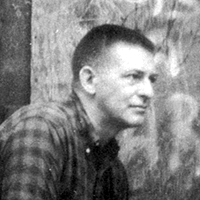Success Starts Here
Your gateway to the Library Catalog, Digital Items, Library Website search results, and more simultaneously!
Your gateway to the Library Catalog, Digital Items, Library Website search results, and more simultaneously!


Donald P. Olsen was born in Provo, Utah in 1910. Although he was not associated with a college or university, he is considered one of the most significant of the second generation Utah modernists and one of the most persuasive figures of nonobjective art in Utah. He died in 1983 in Salt Lake City.
Olsen first studied music at Brigham Young University 1935. Olsen began his professional painting career in 1951. He continued his education in art at the University of Utah in 1950. Later Olsen made frequent trips to New York where he had access to the important abstract expressionists of the New York School.
In 1952, Olsen won third place in the Utah State Fair exhibition. Andalusian Elegy was part of the All-Utah Exhibition. In 1953, his painting Abstraction #4 won the Purchase Prize at the Utah State Fair.
Biography adapted from Springville Museum of Art.
A classical violinist turned abstract painter, Donald Olsen is considered the most significant of the “second generation“ of the Utah modernists. Don Olsen was born in Provo, Utah, on the 3rd of December, 1910. He did his undergraduate work at Brigham Young University and then continued his education at the University of Utah. After graduation, Olsen taught at Provo, Lincoln, and Jordan High Schools, and later at the College of Southern Utah, where he taught music and art. He also was an art instructor at the Art Barn in Salt Lake City.
Olsen has been called one of the most persuasive figures of non-objective art in Utah from the 1950s to the 1980s. Because of his dedication to modernism, the development of his painting style has paralleled contemporary art's evolution. He has experimented with almost every contemporary style of painting from the “brushed-action painting“ of Abstract Expressionism, to the “hard-edge“ of Minimalism. In 1955, he had a solo show at the Salt Lake Art Center, where he became known for “thickly painted-with-muscle brushwork.“ Later on in his career, Olsen's work moved towards a type of Geometric Purism that had its beginnings with artists such as Piet Mondrian.
According to James Haseltine, “Following his marriage to Betty in 1962, Don Olsen did some of his more lively work, a series of canvases dominated by white used as positive shape, negative passage or ground, dripped line, or textural splatter. His colors are most often used unmixed, directly from the tube, alla prima, with reds most prominent and blues, greens and yellows playing a secondary role.“
Don Olsen studied with Hans Hoffmann at Provincetown, Massachusetts, in 1954. Later, his frequent trips to New York gave him access to the important twentieth-century abstract painters. He was profoundly influenced by the New York School and always returned from his trips full of vigor. He was Utah's conduit to the cutting edge of the American avant-garde. The painting Chelsea VI belongs to the New York School of Minimalist, Hard-Edge art, popular from the late 1960s to the early 1980s.
An unpretentious, sensitive, and intellectual man, Don Olsen was the leading exponent in Utah of nonobjective and experimental art. In his own words, his philosophy of painting is simply stated.
“Painting is not an illusion. A painting can only be itself; it does not simulate, borrow from, or pretend to be anything outside itself. It is a real thing and its reality lies in being itself. A painting reveals the internal expression of the artist and has nothing to do with observation of visual facts.“
Biography courtesy Springville Museum of Art.
Books
Dunbier, Lonnie Pierson, ed. The Artists Bluebook: 29,000 North American Artists. Scottsdale, AZ: AskART.com, 2003.
Olpin, Robert, S., William C. Seifrit, and Vern G. Swanson. Artists of Utah. Salt Lake City, UT: Gibbs Smith Publisher, 1999.
Swanson, Vern G., Robert S. Olpin, Donna Poulton, and Janie L. Rogers. 150 Years Survey Utah Art, Utah Artists. Layton, UT: Gibbs Smith Publisher, 2001.
Swanson, Vern G., Robert S. Olpin, William C. Seifrit. Utah Painting and Sculpture. Layton, UT: Gibbs Smith Publisher, 1991.